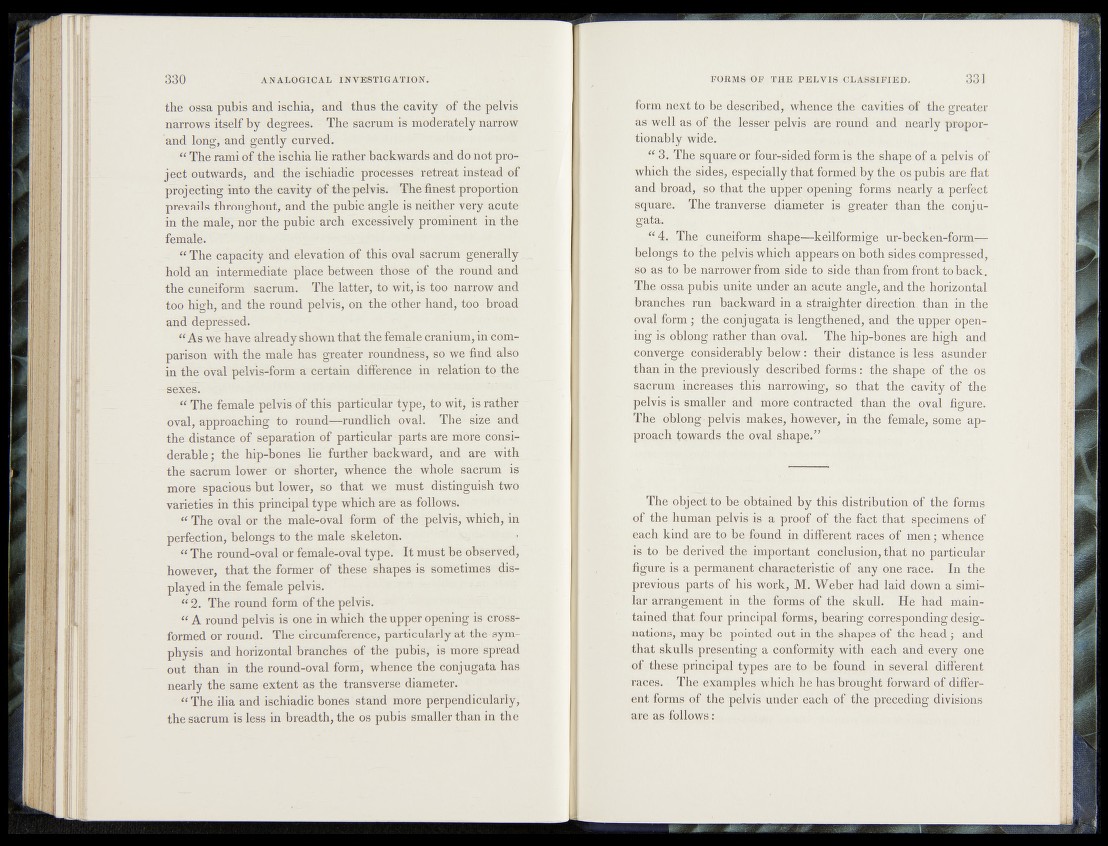
the ossa pubis and ischia, and thus the cavity of the pelvis
narrows itself by degrees*~ The sacrum is moderately narrow
and longi and gently curved.
“ The rami of the ischia lie rather backwards and do not proje
c t outwards, and the ischiadic processes retreat instead of
projecting into the cavity of the pelvis. The finest proportion
prevails throughout, and the pubic angle is neither very acute
in the male, nor the pubic arch excessively prominent in the
female.
^ “ The capacity and elevation of this oval sacrum generally
hold an intermediate place between those of the round and
the cuneiform sacrum. The latter, to wit, is too narrow and
too high, and the round pelvis, on the other hand, too broad
and depressed.
“ As we have already shown that the female cranium, in comparison
with the male has greater roundness, so we find also
in the oval pelvis-form a certain difference in relation to.the
-sexes.
“ The female pelvis of this particular type, to wit, is rather
oval, approaching to round—rundlich oval. The size and
the distance of separation of particular parts are more considerable;
the hip-bones lie further backward, and are with
the sacrum lower or shorter, whence the whole sacrum is;,
more spacious but lower, so that we must distinguish two
varieties in this principal type which are as follows.
« The oval or the male-oval form of the pelvis, which, in
perfection, belongs to the male skeleton. v
“ The round-oval or female-oval type. It must be observed,
however, that the former of these shapes-is sometimes displayed
in the female pelvis.
" 2. The round form of the pelvis.
“ A round pelvis is one in wliich the upper opening is cross-
formed or round. The circumference, particularly at the symphysis
and horizontal branches of the pubis, is more' spread
out than in the round-oval form, whence the conjugata has
nearly the same extent as the transverse diameter.
M The ilia and ischiadic bones stand more perpendicularly,
the sacrum is less in breadth, the os pubis smaller than in the
forlpMgxt tb'fbp^sCidbed, whencdtbe cavities of the greater
^lesserjpel^b' are round and nearly proportionafely
wide. ,
a 3. ThC-sfuare or dour.-sided“fprm is the shape of a pelvis of
which tumsidps, jespeciall y, th^ forpted ,by the os pubis are flat
and broad, so; that the uppm^pe^ing forms nearly a perfect
square.. The tranverse,, diameter is greater ,.fhan the (jonju-
gataV .
“ 4. The cuoejfpim \shape—keilfpimigq ^ur-becken-form—
belongsthesp'eljvis, which *appears;on -both sides compressed^
so „as to|he najrrpw'erfrqm,§ide tp side.* than from front1 to back.
The .qssajpuJjis uniti^under an ao)ite,a^^e, and thS o rizo n ta l
branches run backward in|a;'Strapghter.direction, than m the
oval form; the conjugata is lengthened, and the upper open-
ing feOplong’frather than oval.., AThe hip^-bonei1 aneljhigh and
converge1 - considerably‘below: their ^istauce^i§|pld asunder
than imthe previously dig^l^ed forms: the shape of the os
sacrum increases this narrowing, so^that the cayit^ ^S th e
pelvis is smaller and- more contracted
The oblpng^pelyfej makes, however, in the female, some approach
^qwards the oval shape.”:,;
The object to be obtained by this distribution of the forms
of the human pelvis is a proof of the fact that specimens of
each kind are to beffound in different races of, men; whence
is to be derived the important conclusion^hat no particular
figure is a permanent;characteristics of any onerace. In the
previous parts of his work, M. Weber had ’down a simijl
lar arrangement in the forms of the skull. He had maintained
that four principal forms, bearing^cprresponding designations;
1 may be pointed out in the shapes of the h e a d ; and
that skulls presenting a conformity with each and,every one
of these principal types are to be- found in several different
races. The examples which he has brought forward of different
forms of the pelvis under each of the preceding divisions
are as follows: